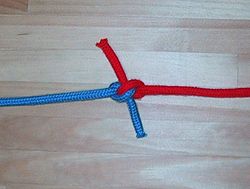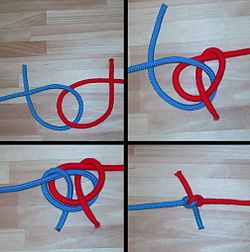m |
(Marked this version for translation) |
||
| Line 2: | Line 2: | ||
</noinclude> | </noinclude> | ||
| + | <!--T:6--> | ||
{{ | {{ | ||
| + | <!--T:7--> | ||
Knot | Knot | ||
| name= Hunter's bend | | name= Hunter's bend | ||
| Line 14: | Line 16: | ||
Hunter's bend is one of the most recent knots to be discovered. It appeared on the front page of ''The Times'' in 1978 and was credited to Dr. Edward Hunter. Dr. Hunter used it for years to tie broken shoelaces before discovering its originality through a friend in the 1970s. When it appeared on the front page, it led to much publicity for the knot and also to the foundation of the International Guild of Knot Tyers. However, the knot was presented in '''''Knots for Mountaineering''''' by Phil Smith ca. 1956. | Hunter's bend is one of the most recent knots to be discovered. It appeared on the front page of ''The Times'' in 1978 and was credited to Dr. Edward Hunter. Dr. Hunter used it for years to tie broken shoelaces before discovering its originality through a friend in the 1970s. When it appeared on the front page, it led to much publicity for the knot and also to the foundation of the International Guild of Knot Tyers. However, the knot was presented in '''''Knots for Mountaineering''''' by Phil Smith ca. 1956. | ||
| + | <!--T:8--> | ||
}} | }} | ||
Revision as of 20:28, 3 February 2017
| Hunter's bend |
|---|
|
Use: The Hunter's bend (aka Rigger's bend) is used to join two lines. It consists of interlocking overhand knots, and can jam under moderate strain.
Hunter's bend is one of the most recent knots to be discovered. It appeared on the front page of The Times in 1978 and was credited to Dr. Edward Hunter. Dr. Hunter used it for years to tie broken shoelaces before discovering its originality through a friend in the 1970s. When it appeared on the front page, it led to much publicity for the knot and also to the foundation of the International Guild of Knot Tyers. However, the knot was presented in Knots for Mountaineering by Phil Smith ca. 1956.
|


